Responding to the disaster
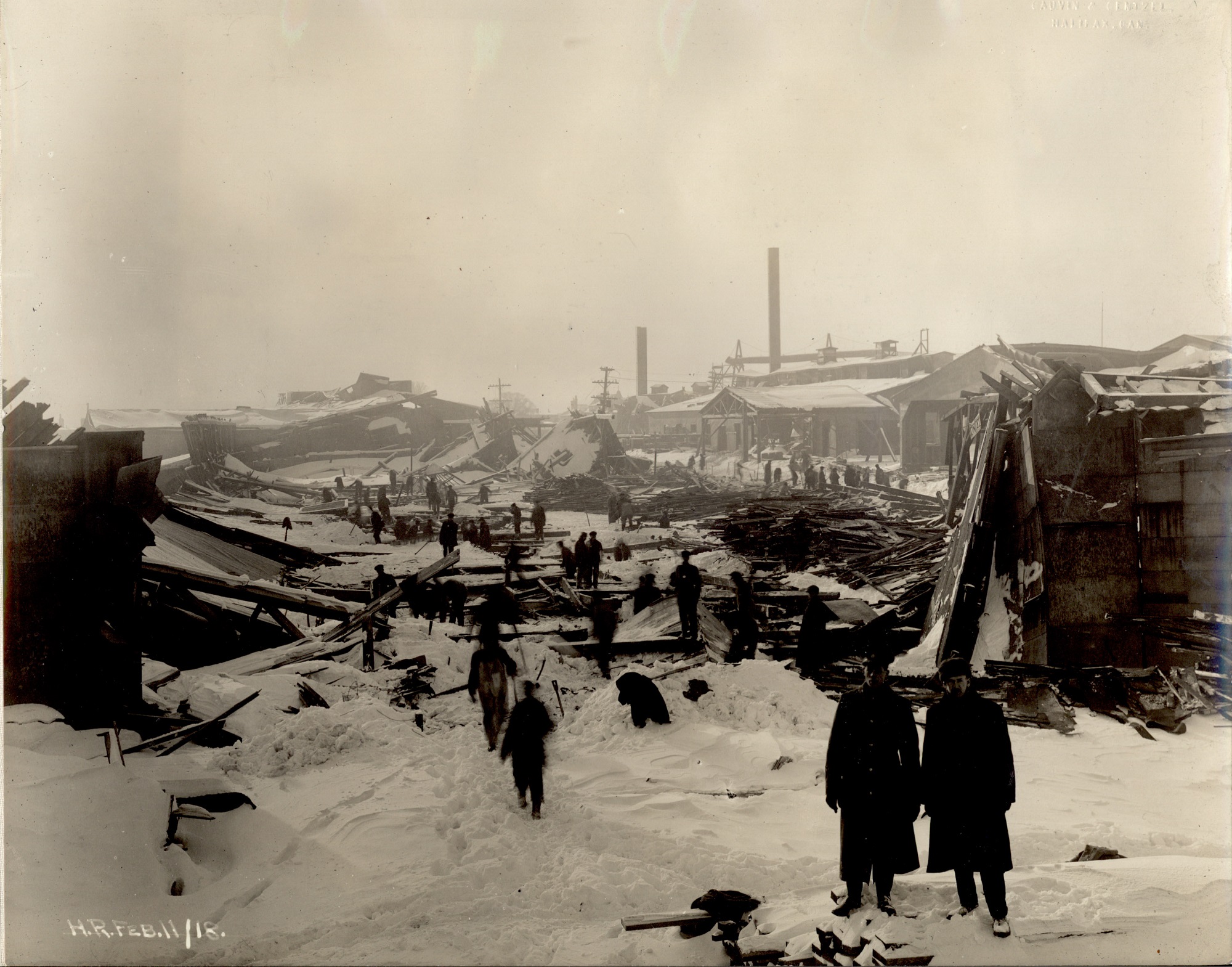
caption
Halifax, N.S.: Ruins of car erecting shed.By Jessica Briand, Piper MacDougall, Stacey Seward, and Josh Young
Halifax has long celebrated the contributions of the relief team from Massachusetts, who played a huge role in the early days of Halifax’s recovery from the explosion. There were many local heroes as well, who came together in the chaos of the minutes, hours and days after the blast. Many of their stories were recorded by the official historian of the explosion, Archibald MacMechan, and other historians and researchers. King’s students searched through the records to find their stories
Medical response within minutes
In the minutes and hours after the explosion tore through the North End of Halifax, the scene in the streets was chaotic.
Fears of a second explosion at an ammunition depot sent people fleeing southward, while others tried to get closer to the North End to help.
Florence Murray was a fourth-year Dalhousie College medical student from O’Leary, PEI. Like many, she first thought Halifax was under attack. She quickly obtained some bandages and iodine and began dressing the wounded as she made her way to Victoria General Hospital.
“The patients were covered with black. Impossible to get the black off,” said her personal narrative, as recorded by MacMechan.
Murray went on to Camp Hill, a brand new hospital that was already overflowing with the injured.
Conditions were dire. By the end of the first day, Camp Hill—which was built to accommodate about 300 patients— was dealing with many times that.
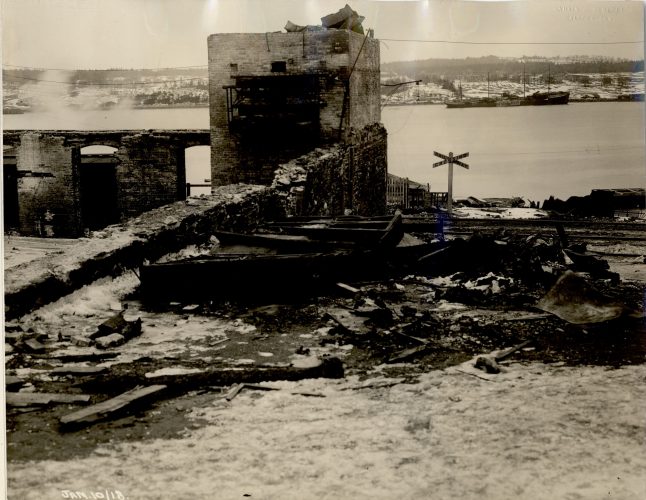
caption
Damage on the Halifax side of the Narrows. The Imo, the ship that collided with the Mont-Blanc, can be seen in the background on the Dartmouth side.Those less injured were turning back from the hospital voluntarily, “on seeing the human wreckage around them,” she recounted.
“[I] was taking glass out of people all day and saw many eye-cases.” The windows were blown out, so patients were “shivering with the cold.”
Three temporary operating rooms were pressed into use.
The garrison hospital at Cogswell and Gottingen streets cared for 400 wounded on that day, and in spite of collapsed ceilings, never ceased functioning. Staff used kitchen utensils as makeshift surgical instruments. The cold wind howled through shattered windows, and doctors and nurses worked until they could work no longer.
Despite the endless stream of stretchers and bloodied bodies placed wherever there was room, Murray couldn’t help but notice the “organization without any organization.” Nobody in particular was in charge, but people seemed to gravitate to where they were needed.
Even the injured put the welfare of others ahead of their own.
Murray had a small amount of morphine to give to the suffering, but many patients told her to “give it to someone who needs it more” when she offered it to them.
She worked every day till Christmas.
Dr. George Murphy also noted the sense of fortitude among the injured.
“They gave little evidence of the suffering they endured. There was little groaning or complaining, and apart from the occasional crying of the wounded babies and little children, an almost uncanny quiet prevailed the wards and available spaces of the hospital,” he recounted to MacMechan.
“When you read everything, it’s the Massachusetts nurses and doctors that get all the accolades. But in reality, for three days, the local nurses and doctors held the fort,” Gloria Stephens, president of Nursing History Nova Scotia, said in an interview.
Although the war had left a shortage of doctors and nurses in the city, many military medical staff in Halifax at the time had experience working in crisis situations overseas, according to Stephens. She said that many nurses performed tasks that they would never be permitted to do in ordinary situations, like giving anesthetic, removing glass and suturing wounds— things they had become accustomed to doing while working in a war zone.
Morgues and the identification of casualties
While Murray bandaged the wounded, Professor McRae and Richard H. Williams became integral to another aspect of relief: dealing with the onslaught of the dead.
The grim nature of the situation quickly became apparent, and a place had to be found for all of the bodies as more and more were recovered. Many were hard to identify because their injuries were so severe.
To get the bodies off the streets and allow for people to find and identify their loved ones, a morgue was established in the basement of the new Chebucto School. According to one of the reports among MacMechan’s materials, called Morgue at Chebucto School, McRae and Williams were in charge of organizing and identifying bodies that were brought to the dark, cold basement. McCrae worked in the morgue for 16 days straight, from Dec. 9 to Christmas Day, according to the typed account.
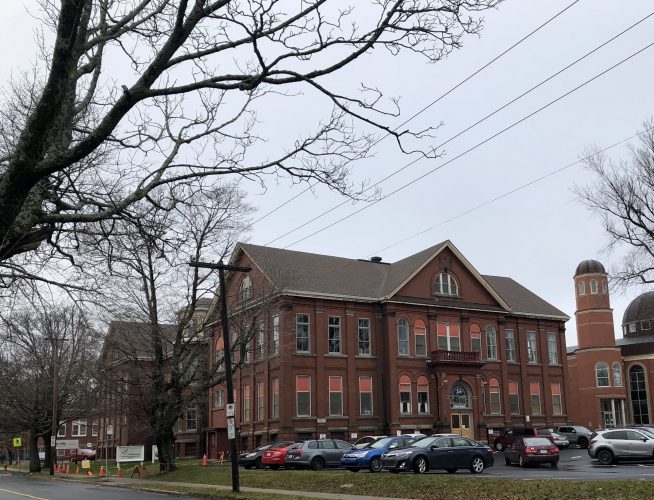
caption
The Chebucto school as it stands today.The document tells the stories of identifying four different people, including Frank Lemiuex, an engineer on a steamer that was in the harbour.
Lemiuex’s fiancee came to the morgue accompanied by a man. The man went down to the morgue with McRae while the fiancee remained in the office.
At first, the man was sure the body marked as Lemieux’s wasn’t his. However, the belongings that had been set aside as Lemieux’s, including an emerald ring, were recognized by Lemieux’s fiancee. She also said her fiance had a tattoo.
The body wasn’t positively identified until soldiers washed the dead man’s arms to reveal the tattoo, reading “hands across the sea.”
Difficult conditions often made it hard to keep bodies property identified, according to the narrative.
“Each body was given a number on a ticket, but as the windows of the basement were broken by the explosion, snow and rain came in, obliterating the numbers. The soldiers in charge made mistakes recopying the numbers.”
Even today, historians and archivists struggle to determine exactly how many people died, and sometimes, who they were. As an example, the online remembrance book maintained by the Nova Scotia Archives has recently removed approximately a hundred entries as archivists have worked to eliminate duplicates and other errors.
“It doesn’t mean the number of people who were killed goes down,” Garry Shutlak, senior archivist at the Nova Scotia Archives said.
“What it means is that when you find that Nellie Smith, and Eleanor Smith, and Mrs. James Smith are all the same person, we then decide that two of those have to be removed and we keep one, because this is the sort of thing that happened….One of them has to be right; the other two have to be wrong.”
According to Shutlak, that doesn’t mean there weren’t two other bodies without identification; it just meant that they weren’t identified correctly in the first place.
People were working hard under difficult conditions and stress.
“I think they were hoping there would be more recovery of people who were alive, than people who were actually dead,” Shutlak said.
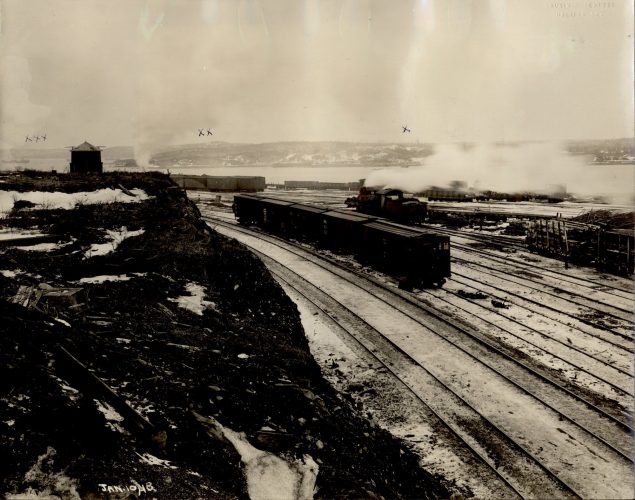
caption
The railway yards slightly north of the site of the explosion. The single “x” marks the spot on the Dartmouth side to which a freight car was washed from Halifax by the tsunami sparked by the blast.Today, the Maritime Museum of the Atlantic features an exhibit of handkerchiefs.
“In a museum context, they’re usually shined up or ironed and washed but these were all crumpled and filthy just like they would have been when they were put in the mortuary bags…on the day after or two days after the blast,” said Roger Masters, curator of Marine History at the Maritime Museum of the Atlantic.
“So they form an amazing sort of immediate connection with the consequences of the event,” he said. “It really gives you a pointed, visceral sense of the impact.”
Women, class and relief
With Mayor Peter Martin out of town, Deputy Mayor Henry Colwell had to take responsibility for hastily organized relief efforts. He immediately rallied 5,000 sailors and soldiers to help, according to The Halifax Explosion: Heroes and Survivors by Joyce Glasner.
Two hours after the blast, the deputy mayor, Lieutenant Governor Macallum Grant, Justice Harris, five Aldermen and 12 citizens sat among debris and broken glass in City Hall. This would be the first Halifax Relief Committee meeting; these would continue up to three times a day for several weeks.
The explosion threw social worker Jane B. Wisdom into the role of supervisor on the rehabilitation committee. She soon became a local hero and pioneer in Halifax Social Work, Suzanne Morton wrote in her 2014 book Wisdom, Justice and Charity.
On the morning of Dec. 6, Wisdom was overcome with a migraine. Unable to concentrate, she left her office and sauntered down to Barrington Street in search of Aspirin: it was a walk that would save her life, according to Morton’s book.
The explosion plastered her office desk with glass and broken objects. She survived unscathed.
Wisdom had recently moved to Halifax to work as the first and only professionally trained social worker in the city at the newly established Bureau of Social Services.
“[Widsom] got a bunch of local charity workers to start organizing relief,” said Michelle Hébert Boyd, social worker and author of the Halifax Explosion book Enriched by Catastrophe.
“She arranged things like getting food, blankets and clothes to people.”
“She is also recognized for surveying the devastated area, making lists of who had survived and who was missing, so that they could try to start locating people and matching up family members,” Boyd said.
Food was properly distributed the afternoon of Dec. 7 because of the tireless effort and tedious paperwork kept by Wisdom and another secretary, Mrs. Freeman. The pair were praised by the St. John Ambulance Brigade, according to Morton.
The day after the explosion, a fierce Maritime blizzard blew into Halifax, burying bodies that were already covered in rubble and shattered glass. It was misery piled on misery, and further complicated relief efforts.
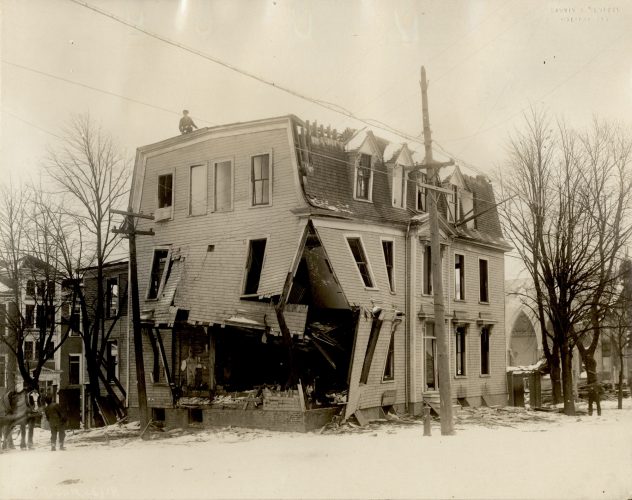
caption
Severe damage caused by the explosion.Mrs. F. E. Sexton was in Fredericton campaigning for the reelection of Sir Robert Borden’s union government when she heard of the disaster at home in Halifax that morning.
She boarded the train carrying relief workers from Boston, according to her personal narrative recorded by MacMechan. The train’s engine plowed through mountains of snow on the tracks and arrived in Halifax at about 6:30 in the morning on Dec. 8.
No one was there to greet them, so she “‘skedoodle[d]’ down to the town herself.”
After finding her way back into town, Sexton dove headlong into the relief effort.
In her narrative, MacMechan noted that she ferried medical supplies to “various hospitals” and brought back wounded on makeshift stretchers made by laying doors across the car.
Her narrative also reflects what seems to have been some resistance to women becoming full-fledged participants in the disaster response.
“At the meeting in the afternoon, there was a distinct feeling not to allow the women to take part in the relief work, or have them on the committees,” Sexton’s personal narrative indicates.
It goes on: “Mrs. Sexton spoke [at the meeting]. ‘All the women’s organized effort of the city is at your disposal’,” she told those assembled.
Women were ultimately made part of various committees and continued playing an important role in the disaster response.
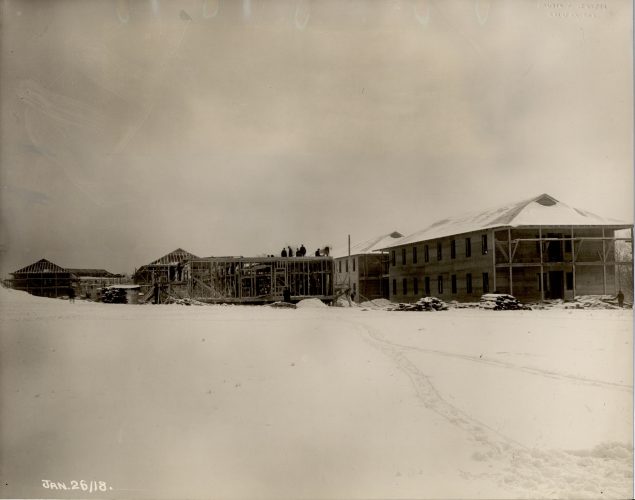
caption
Temporary apartment buildings being built at the foot of the Citadel.Interestingly, the disaster resulted in a dissolving of some of the class differences that characterized Halifax at the time.
“Anytime there’s a disaster it automatically dissolves,” Shutlak said.
“Obviously when you have a major disaster everybody works together as quickly as possible, and the idea that the person working next to you is a blue collar worker and you own a business is not important. What’s important is to get the work done.”
Ismael Aquino, who works for Dalhousie’s School of Health Administration and is the former provincial director of the Canadian Red Cross, explained that the medical workers would have used a priority system to figure out who needed to be treated first. People who could be saved but wouldn’t be without immediate medical attention were usually at the top of the list. Your class or status didn’t matter.
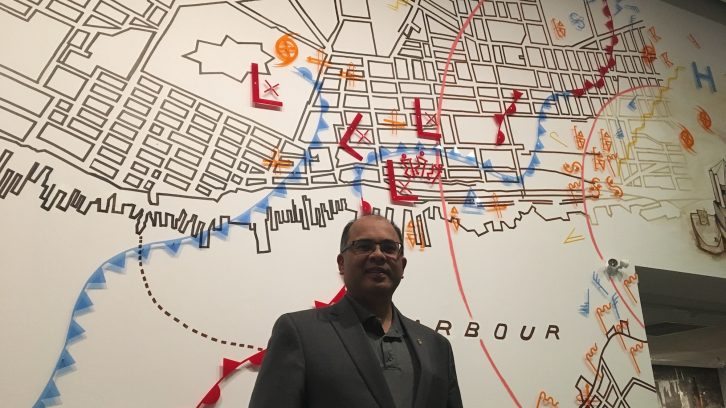
caption
Ismael Aquino in front of a mural of the explosion in the Dalhousie Art Gallery.“It’s amazing how humans are able to do the task, you’ll be surprised what you’re capable of doing under stress,” Aquino said.
The explosion also resulted in important legacies.
Aquino said it forced Canada to put a national disaster system in place. In 1919, the Canadian government created the Department of Health, which eventually became Health Canada.
“The mindset changed where we have to think about the unthinkable and be prepared for that,” Aquino added.

